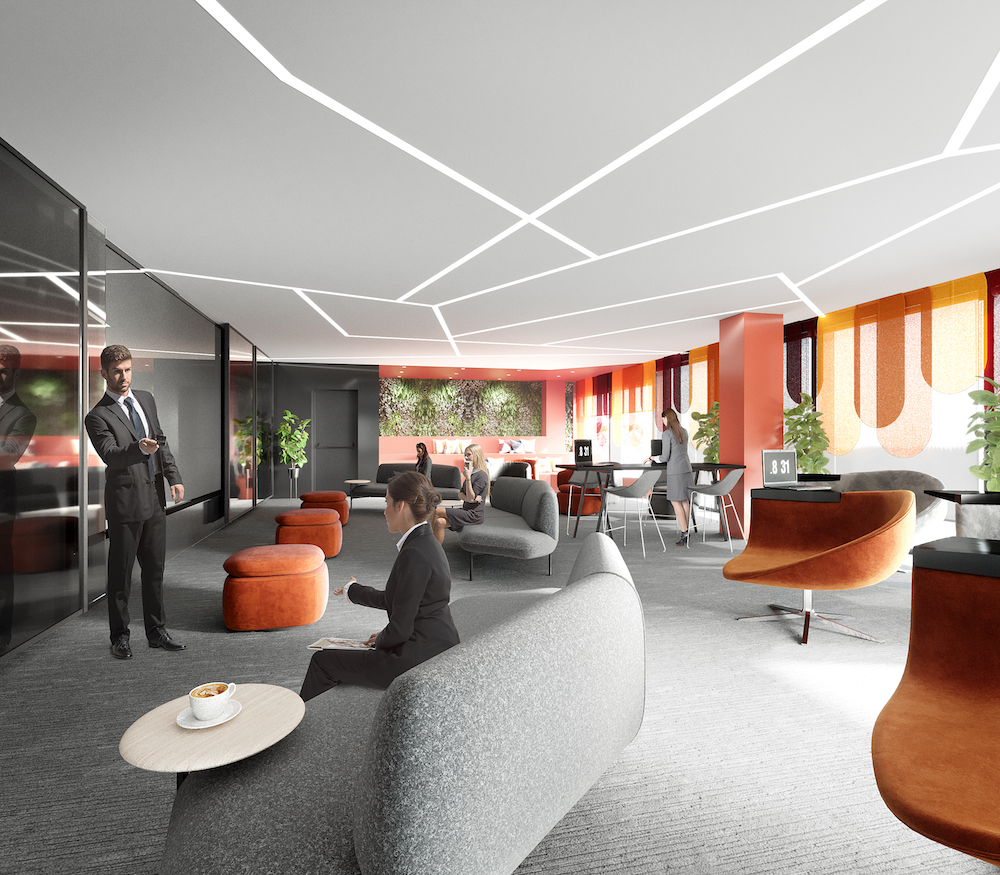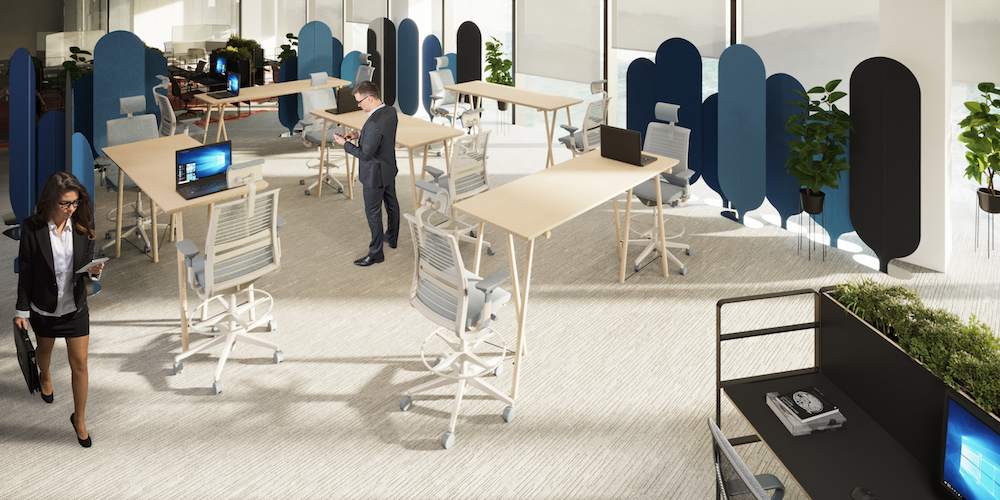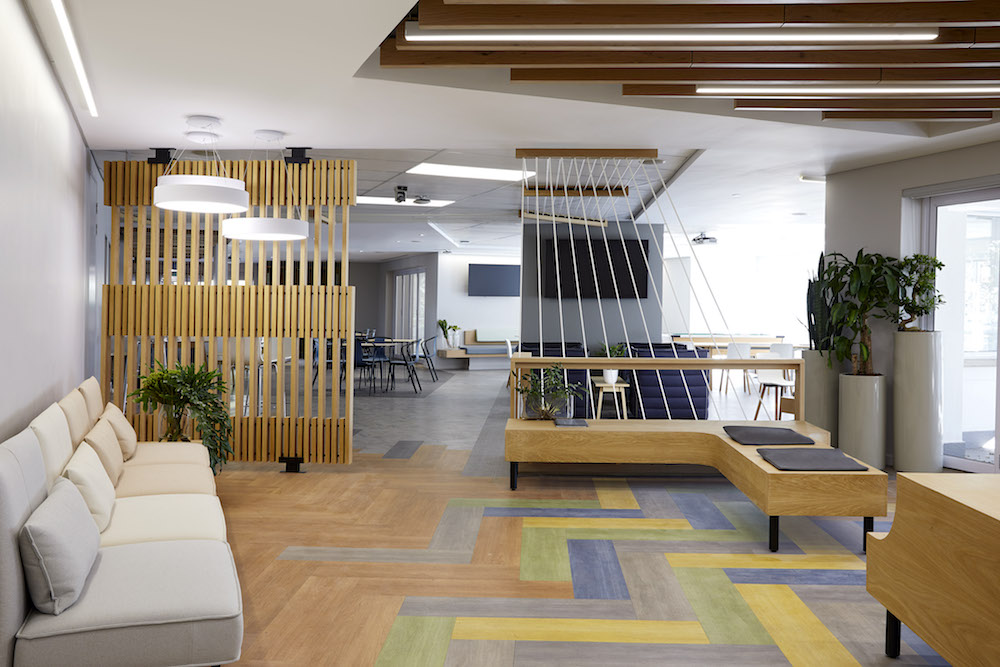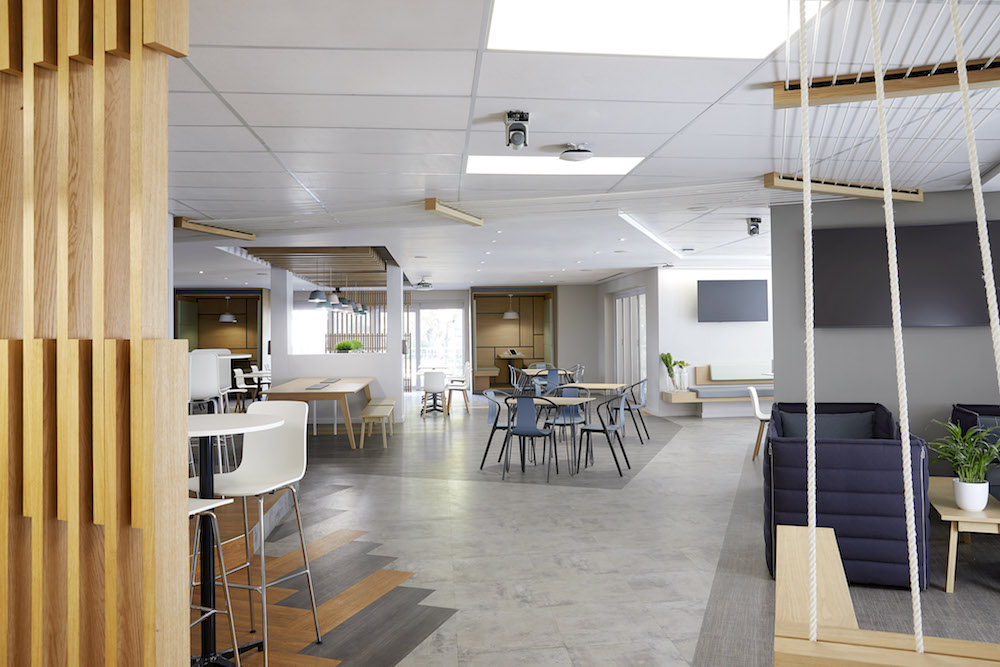As companies rethink what they want from the post-lockdown workplace, they’re taking a closer look at how they are using space and asking, how can it better meet their needs.

Pivot spaces – or multi-functional areas of the office – are not new, but social distancing measures and a focus on improving the employee experience in the office are making them a key feature of tomorrow’s workplace.
At the start of the year, companies were not thinking about social distancing as a workplace priority but in a short space of time, it has become central to office design.
With employees now returning to the office and coronavirus still a lingering threat, more businesses are thinking about how to best adapt their spaces.
Designed well, these pivot spaces can help to make the office somewhere people want to be. So why should we incorporate pivot spaces into the office now?
To promote health and safety
Employee health and wellbeing are at the heart of the current office rethink. Pivot spaces can be used to distribute staff around the office to maintain physical distancing and adapt accordingly as workplace guidelines change.
Well-designed pivot spaces can also help employees feel at ease in their surroundings. Plants and relaxed color schemes can promote a calming effect. And right now, wipe-clean surfaces and materials can also reassure staff.
To create a sense of community
Pivot spaces are popular places for internal team gatherings that allow colleagues to collaborate and strengthen working relationships. While the pandemic has made us more familiar with conference calls, there’s no replacement for a physical gathering and the spontaneous ideas it generates.
Ensuring design supports interaction does not mean “reinventing the wheel” and investing large amounts of capital in furniture. But meeting spaces can be reconfigured to encourage socially-distanced groups. These spaces will be de-densified, including the removal of some chairs to ensure seating arrangements comply with current social guidelines.

There are also specific room configurations that facilitate safe gatherings and collaboration:
- Half-moon space – the room, available for larger internal meetings is arranged into a half moon shape and the furniture provides adequate power solutions and surfaces for laptops. There are varying heights and types of furniture in this space, which ensures that everyone feels comfortable and engaged. In the centre of the half-moon, is a large video conference TV, allowing remote workers to dial in.
- Huddle space – with comfortable seating that both encourages distancing and allows for the productive use of personal devices. The arrangement is flanked with screens which allow the team to share their screens and collaborate.
- Work café – Employees are seated on bar-height stools with screens separating them and planting serving to reduce close encounters. It is an energetic setting that encourages informal connection among colleagues.
- Open workspace – In the quiet workspace, the number of traditional workstations has been reduced. Employees make use of the company’s app to book a desk for the day. The smart re-arrangement of seating to the short ends of tables allows for greater distancing between individuals. Screening also gives the sense of privacy and comfort. Although the demand for this space has been reduced as a result of remote working, it is vital that employees can find a retreat to focus and work with colleagues in an environment that puts them at ease.
- Fireplace room – This former boardroom has large armchairs socially distanced for small groups, complete with a hologram of a fireplace. It enables a team to talk in an intimate, private environment that sparks imagination and a sense of community.

The importance of furniture
Furniture choices in pivot spaces should encourage both distancing and productivity. Modular furniture, that can be moved and repurposed, is a good choice for both short-term social distancing and longer-term flexibility. High-back, single-seater pods provide comfort and privacy for calls or focus work while larger pods facilitate semi-private small group meetings.
The provision of physical screening is important and can form part of the design; playing with shapes, materials and finishes will provide both visual pleasure and introduce physical barriers into a space. Spatial divides can take many forms and shapes, for example the introduction of organic shapes can direct the movement of staff through a space. Also, custom-made furniture/ joinery can be designed to encourage distancing and introduce visual interest using smart planning and lighting. These features can add character and create a sense of wellbeing in an office.
To support client interactions
It’s not just about creating a pleasant work environment for staff; pivot spaces should be adaptable to support interaction with clients in digital presentations and face-to-face negotiations.
Why should business meetings feel cold and formal? Post lockdown, clients visiting offices could be ushered into a small, sterile room with intimidating Perspex/Plexiglass screens in place. But spaces should be inviting and appealing, yet still professional to create a positive experience. A library or fireside room, for example, could be used for smaller client meetings as an alternative to large echoey boardrooms.

To ensure strong connectivity
As offices get smarter, technology is getting more integrated across all types of pivot spaces. These spaces will utilize technology to help facilitate a contactless workplace, centered around hygiene as well as enhancing the user experience. We expect to see many companies using portals or apps to control employee experience within an office space.
These portals will include the choreographing of staggered working hours/ start times, the completion of health questionnaires, biometrics, room booking, lighting and temperature control, and even touchless catering ordering.
We’ve all grown accustomed to sitting in rows simply because of cabling and wiring, but as we’ve all realised during remote working, tasks do not need to be carried out in one designated area for a set eight-hour period. Instead, wireless internet needs to support everything from video calls to large file transfers with plenty of charging points for electronic devices – some even built into furniture.
To reflect a brand
Pivot spaces offer an opportunity to enhance company culture and reflect its values.
The benefits are two-fold: visitors get a better feel for a company’s vision and brand when they see an open, collaborative workplace, while the right working environment can help employees feel part of something greater.
We know that many companies are analyzing their workplace for the future and rethinking the role of the office. We believe a quick and efficient win is to adapt existing spaces into pivot spaces. While this is not a new concept, it presents a fresh way of reconfiguring workspaces for the next version of the office.

